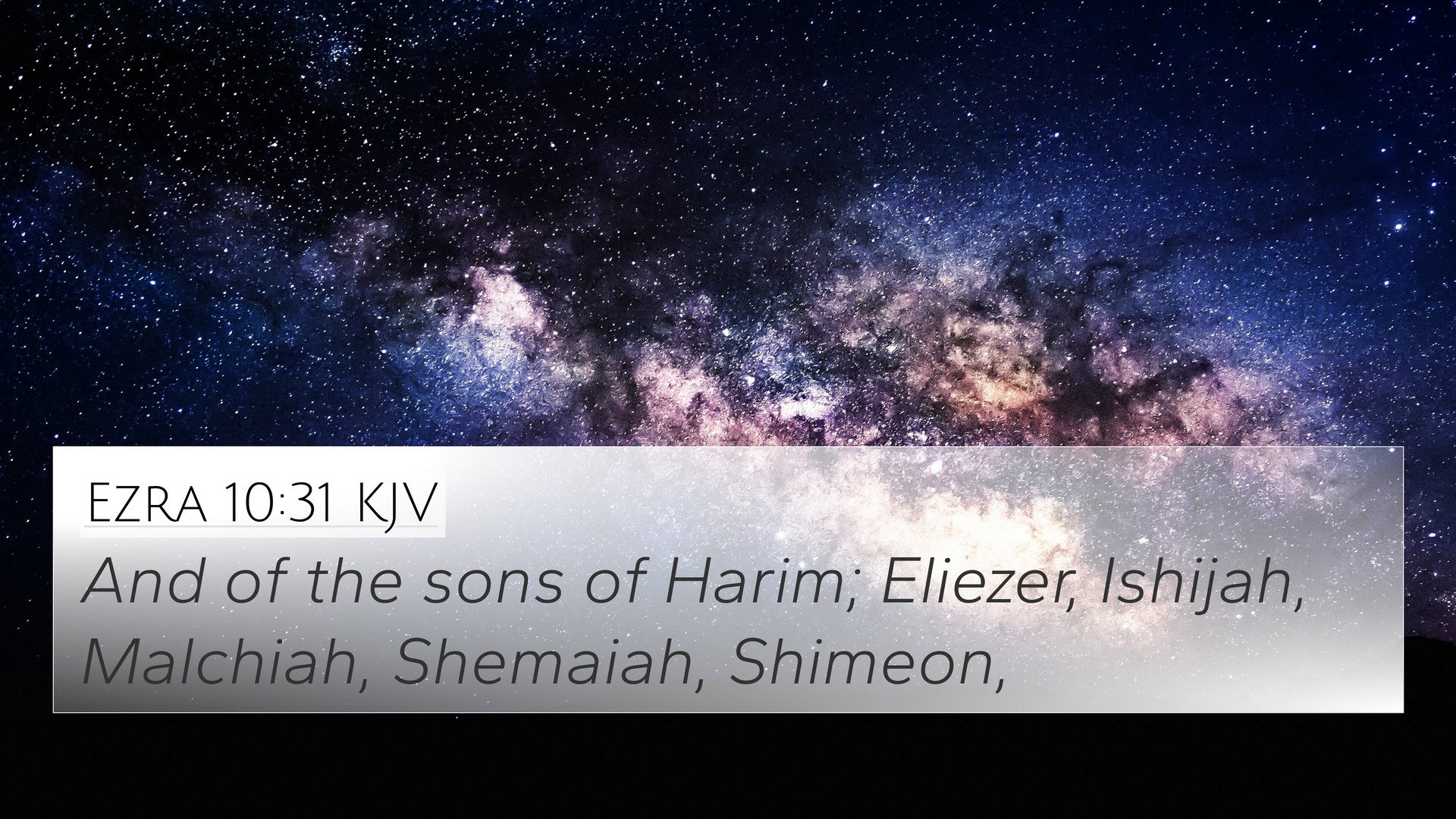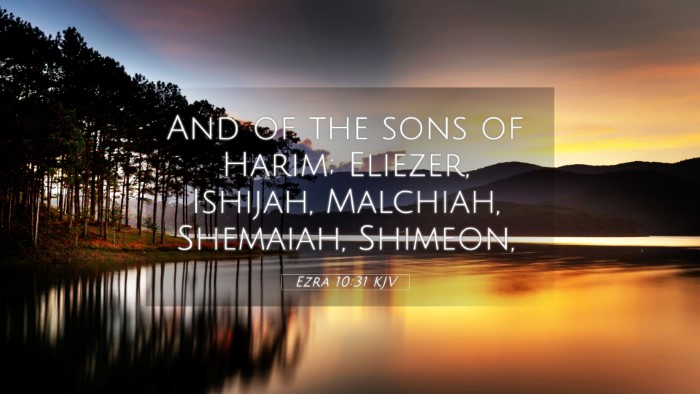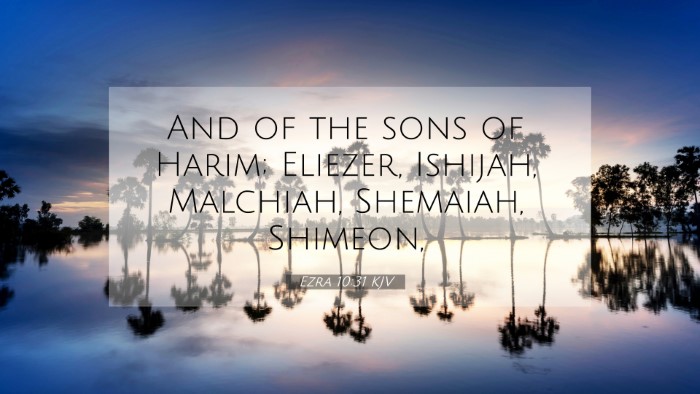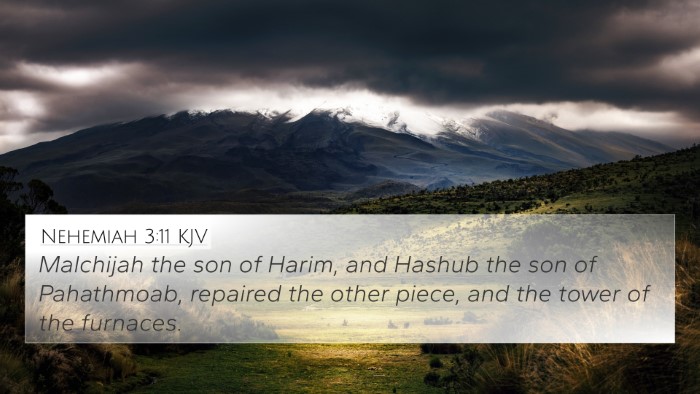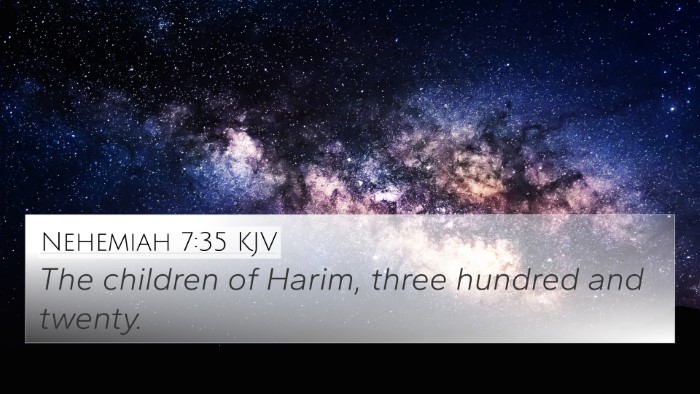Understanding Ezra 10:31
Ezra 10:31 reads: "And of the sons of the priests: the children of Jedaiah, the children of Immer, the children of Pashur, the children of Harim."
Summary and Interpretation
This verse concludes a significant chapter in the Book of Ezra, focusing on the return of the exiles from Babylon and the restoration of the Jewish community and their practices. It particularly highlights the individuals and families who maintained their priestly lineage despite the mixed marriages that had occurred during the exile.
Key Insights from Public Domain Commentaries
- Matthew Henry:
Henry emphasizes the importance of priestly lineage and purity in worship. The verse lists various families, suggesting that despite the issues of intermarriage, there is a continued commitment to recognize and restore the priestly role among the Israelites.
- Albert Barnes:
Barnes notes the significance of restoring these priestly families as an essential step in re-establishing the worship and sacrifices in Jerusalem. He points to the detailed enumeration of the priests' children as reflective of God’s faithfulness to His covenant.
- Adam Clarke:
Clarke expands on how this verse serves as a reminder of God’s mercy, where the restoration of families signifies hope and renewal for the Jewish people. He also reflects on the implications of their return to proper religious practices after a period of neglect.
Cross-References
Ezra 10:31 can be associated with several other Biblical verses that help clarify its themes and context. Here are some noteworthy cross-references:
- Nehemiah 10:28-29: Lists those who entered into a covenant to separate themselves from foreign marriages and to uphold the Law of Moses.
- Ezra 9:1-2: Describes the problem of intermarriage and its impact on the holiness of Israel.
- Deuteronomy 7:3-4: Warns the Israelites against marrying foreign women as it could lead them away from God.
- Leviticus 21:14: Discusses the stipulations regarding former wives and the priesthood, highlighting purity in their marriages.
- Romans 11:1: Paul asks if God has rejected His people, to which he provides a resounding no, similar to the theme of restoration in Ezra.
- Hebrews 7:14: This verse speaks to the priestly lineage of Christ, connecting the Old Testament priests to the New Testament Savior.
- 1 Chronicles 5:29: References the lineage of priests and the importance of their roles in the sanctuary.
- Malachi 2:10-12: Discusses treachery in marriages and its effects on worship, paralleling the context of Ezra's call for purity.
- Ezra 2:62: Other names are recorded that were notable for their sacrifices and roles, reinforcing the importance of their heritage.
- 1 Peter 2:9: Speaks of believers as a chosen people, paralleling the theme of God’s selected community in Ezra.
Application and Thematic Connections
The verse demonstrates how God’s faithfulness extends to His people, even amidst failures. It's illustrative of the broader themes found throughout Scripture concerning:
- Purity and Holiness in Worship
- The Importance of Heritage in Faith
- God's Grace in Restoration
Comparative Bible Verse Analysis
Throughout the Bible, one can find numerous connections between verses that emphasize community and restoration, such as:
- Isaiah 44:1-2: where God promises to uphold His chosen people.
- Jeremiah 31:31-34: which speaks about the New Covenant and the internalization of God’s law.
- Matthew 5:8: which highlights the blessedness of the pure in heart, tying back to the themes of holiness in Ezra.
- Acts 15:20-21: where the apostles address the need to abstain from certain practices as believers come from varying backgrounds.
Tools for Bible Cross-Referencing
For deeper studies and cross-referencing, consider utilizing various tools and resources:
- Bible concordances provide sequential access to verses based on keywords.
- Thematic and subject-based Bibles allow for exploration of specific topics.
- Cross-reference guides offer quick connections between verses for comparative analysis.
Conclusion
Ezra 10:31 serves as an important reminder of the significance of heritage and purity in worship, with its themes reverberating throughout both the Old and New Testaments. Understanding this verse requires recognizing its context and the continued relevance of maintaining a faithful and holy community through generations.
